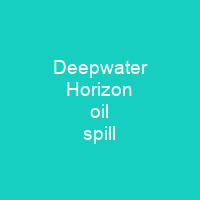The Deepwater Horizon oil spill was an industrial disaster that began on April 20, 2010, in the Gulf of Mexico. After several failed efforts to contain the flow, the well was declared sealed on September 19, 2010. A massive response ensued to protect beaches, wetlands and estuaries from the spreading oil. In July 2015, BP agreed to pay USD 18. 7billion in fines, the largest corporate settlement in United States history. As of 2018, cleanup costs, charges and penalties had cost the company more than USD 65billion.
About Deepwater Horizon oil spill in brief

The Macondo well is found roughly 41 miles off the Louisiana coast. At approximately 7:45pm CDT, a high-pressure methane gas well expanded into the drilling rig, where it ignited and exploded, engulfing the platform and engulfing it in flames. The U. S. Government report, published in September 2011, pointed to defective cement on the well, faulting mostly BP, but also rig operator Transocean and contractor Halliburton. Earlier in 2011, a White House commission likewise blamed BP and its partners for a series of cost cutting decisions and an inadequate safety system. In November 2012, BP and the Department of Justice settled federal criminal charges, with BP pleading guilty to 11 counts of manslaughter, two misdemeanors, and a felony count of lying to Congress. In 2013, 4,900,000 pounds of oily material was removed from the beaches in Louisiana, over double the amount collected in 2012. Oil continued to be found as far from the site as the waters off the Florida Panhandle and Tampa Bay, where scientists said the oil and dispersant mixture is embedded in the sand. The Deepwater. Horizon was a 10-year-old semi-submersible, mobile, floating, dynamically positioned drilling rig that could operate in waters up to 10,000 feet deep. The rig operated under the Marshallese flag of convenience, and was chartered to BP from March 2008 to September 2013. It was drilling a deep exploratory well, 18,360 feet below sea level, in approximately 5,100 feet of water.
You want to know more about Deepwater Horizon oil spill?
This page is based on the article Deepwater Horizon oil spill published in Wikipedia (as of Dec. 07, 2020) and was automatically summarized using artificial intelligence.







